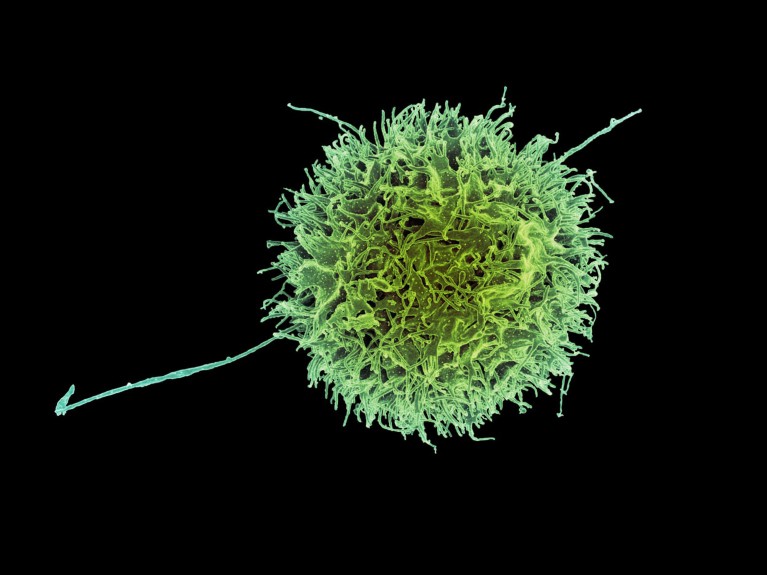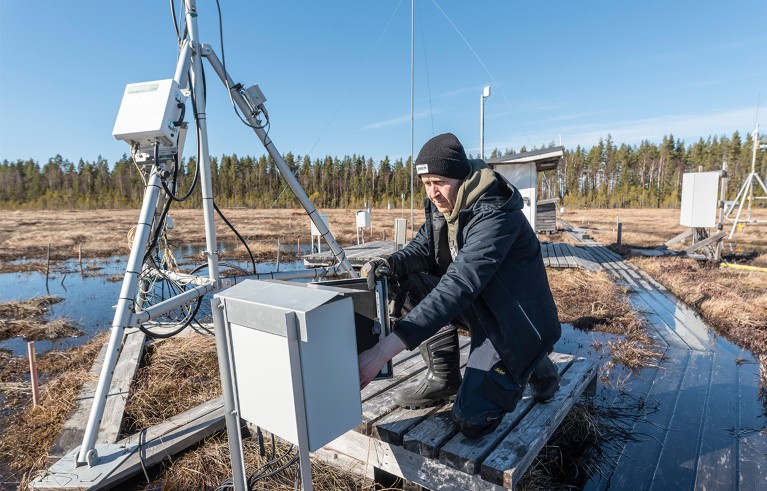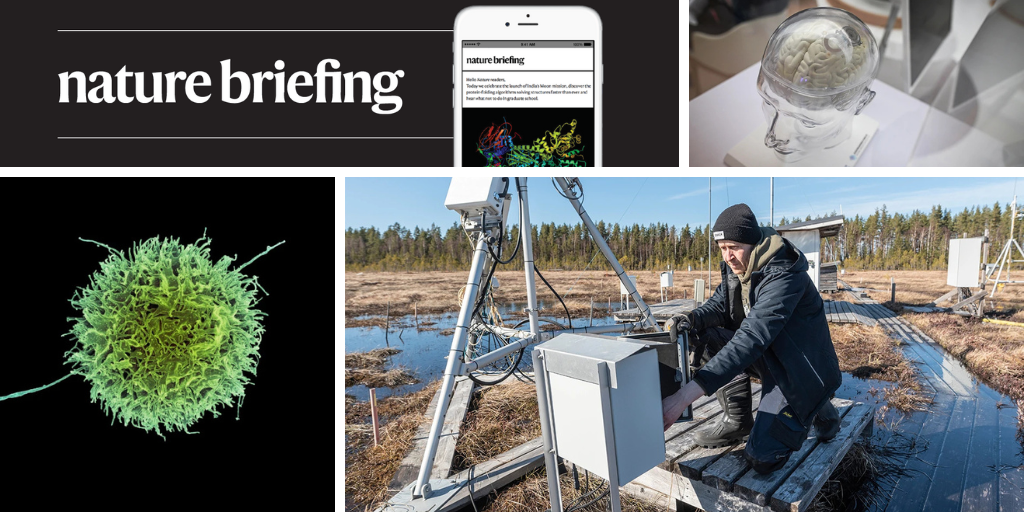You have full access to this article via your institution.
Hello Nature readers, would you like to get this Briefing in your inbox free every day? Sign up here.

The immune-system agents called natural killer cells (artificially coloured) can be bioengineered to attack cells that produce dangerous antibodies.Credit: National Institute of Allergy and Infectious Diseases/National Institutes of Health/Science Photo Library
Immune cells called ‘natural killer’ (NK) cells could be supercharged to attack cells that fuel autoimmune diseases such as lupus and systemic sclerosis. Two small clinical trials suggest that researchers can genetically engineer NK cells to assassinate the renegade cells that produce antibodies against the body’s own tissues. NK cells can be taken from donor blood, making the treatment potentially much cheaper than another, similar approach called CAR-T-cell therapy, which must be manufactured from a patient’s own T cells.
A brain-computer interface (BCI) developed by Chinese medical-technology company StairMed has allowed a man with no limbs to play computer games. The interface has fewer probes than ones developed by billionaire Elon Musk’s US-based company Neuralink, but is smaller and less invasive. It’s one of several in the works in China, where the government has identified BCIs as a priority area of innovation. Others have restored hand movement in a person with paralysis and allowed a person with a tumour in a language-processing area of the brain to communicate slowly in Mandarin.
Scientific publisher Taylor & Francis has paused submissions to its journal Bioengineered so that its editors can investigate around 1000 of the title’s papers that have been flagged as possibly manipulated or originating from paper mills — companies that sell illegitimate manuscripts. The hallmarks of paper mill involvement in the title’s papers were exposed in a preprint in March, in which the authors suggested that the publisher wasn’t taking sufficient action. The pause “feels like a big win for the scientific record”, says biomedical scientist and research-integrity sleuth René Aquarius, who co-authored the preprint.
Reference: arXiv preprint (not peer reviewed)
Features & opinion
There has been a boom in direct-to-consumer health tests that promise to assess a user’s genetic risk of a variety of diseases, or make sense of vague symptoms such as gut problems. Some, such as those for pregnancy, are tried and tested. But others can provide users with inaccurate or easily misinterpreted information. These kits are often marketed as ‘wellness tests’, which helps them avoid the scrutiny of regulatory bodies. And even if the test yields accurate information, such data can be useless to healthcare professionals, which leaves the user back at square one.
This editorially independent article is part of Nature Outlook: Medical diagnostics, a supplement produced with financial support from Seegene.
The deadly flash flooding that took place in Texas over the weekend was “an absolute worst-case scenario”, writes meteorologist Alan Gerard in his detailed analysis of the weather that drove the disaster. The “maximum in rainfall happened to coincide with the headwaters of a particularly flash-flood-prone river with a lot of human beings along it”, writes Gerard. “It also happened in the middle of the night on the 4th of July, exacerbating the human toll.” To head off such disasters, Gerard recommends that the United States maintain a robust National Weather Service and invest in research that improves capacity to forecast and warn for these events — all of which is threatened by government budget cuts.
Balanced Weather blog | 9 min read
Japan is taking steps to restart its idled nuclear reactors and laying the groundwork for more, 14 years after an earthquake led to a nuclear accident at the Fukushima Daiichi nuclear power plant. The country has laid out a roadmap to rebalance its power supply by 2040 in order to reduce its dependence on pricey and polluting fossil fuels. But feelings are mixed in two tiny fishing villages in Hokkaido, where radioactive waste will be stored.
Financial Times | 6 min read & Climate Home News | 9 min read
“☎︎👱♂️👌⛵️🐳” is a sentence familiar to many of us — sort of. It is an emoji version of “Call me Ishmael”, the first line of Moby Dick. The little images might be thought of as an emerging system analogous to hieroglyphics, which also started as a collection of pictures, but it lacks some key features of language, writes Keith Houston in an excerpt from his new book, Face with Tears of Joy: A Natural History of Emoji. With a little help from singer and emoji-virtuoso Cher, Houston argues that emoji are “insurgents within language, a colorful and symbiotic virus whose symptoms we have only haltingly understood”.
Where I work

Risto Taipale is a meteorologist at the SMEAR II station in Hyytiälä, Finland. Credit: Francesco Martinelli for Nature
Meteorologist Risto Taipale studies the ecosystem–atmosphere interactions of fens, a type of peatland fed by groundwater, in Finland. “The instrument box in this photo contains electronics that gather data on soil temperature, heat flux, water content and water-table depth,” he says. Maintaining these systems in such a challenging environment requires “year-round attention to detail”, says Taipale, but it is essential to study fens, which cover nearly half of the global peatland area and have high methane emissions. (Nature | 3 min read)
On Friday, Leif Penguinson was becoming one with nature in the La Quebrada de Santa Bárbara conservation area, Mexico. Did you find the penguin? When you’re ready, here’s the answer.
Thanks for reading,
Flora Graham, senior editor, Nature Briefing
With contributions by Jacob Smith
• Nature Briefing: Careers — insights, advice and award-winning journalism to help you optimize your working life
• Nature Briefing: Microbiology — the most abundant living entities on our planet — microorganisms — and the role they play in health, the environment and food systems
• Nature Briefing: Anthropocene — climate change, biodiversity, sustainability and geoengineering
• Nature Briefing: AI & Robotics — 100% written by humans, of course
• Nature Briefing: Cancer — a weekly newsletter written with cancer researchers in mind
• Nature Briefing: Translational Research — covers biotechnology, drug discovery and pharma


